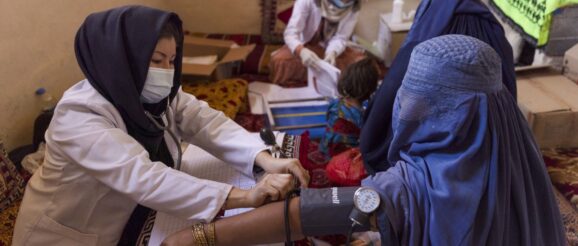Goats and Soda

An Afghan midwife describes how a woman died in childbirth, along with her baby. She was snowed into her village and couldn’t reach a hospital. Just weeks before, the health clinic in her village had closed. If it was open, a midwife could have helped her.

“USAID should not have left Afghanistan. We are devastated,” says Fatima, a 27-year-old midwife, who has worked in maternal care for the past seven years.
Making matters worse, other major European donors have also announced cuts to their foreign aid programs.
“It seems to be that other donors are following the U.S. — what Trump has done is give everyone a license to give up on funding aid,” says Heather Barr of Human Rights Watch. She has focused on Afghanistan closely for decades.
Already, the U.S. aid cuts have caused 206 health facilities to shut down in Afghanistan, according to a World Health Organization count in late March. The WHO report said without urgent intervention, around 200 more facilities would shut down by June, impacting around 2.4 million people.
To give a sense of the ramifications, by February 19 — just a month after Trump was inaugurated and announced a suspension of USAID funding — more than 320 health facilities had shuttered. By March 4, some 153 of the facilities managed to reopen as charities scratched together money, according to Ajyal Sultany, head of communications for WHO in Kabul. But within two weeks, another 39 health facilities had shuttered, according to WHO.
Who bears the brunt
Complications and deaths
Faezeh, 25, is a midwife who had worked in a clinic in an isolated, mountainous district of the western province of Herat. She says villagers had been so happy to have a clinic in their locality because the next nearest health facility was four hours away on treacherous, unpaved roads.
“The clinic was active day and night. There were lots of people coming and going,” says Faezeh, who adds that the clinic –- like many other similar facilities that were recently shuttered –- offered nutrition to malnourished children and their mothers as well as vaccines.
So a few weeks ago, “when the clinic was closed,” she recalls, “people were really upset.” She says village elders begged the public health officer to reopen the clinic, but “there was no donor” to fund its reopening.
Faezeh says since the clinic closed, she got word that a mother and her baby died in childbirth. She says it was “snowing and raining, the roads were blocked,” and there was no way to reach the nearest health clinic. Faezeh says she believes that they would not have died if they had accessed health care. She noted that there had not been a single maternal death when she worked at the village clinic.
Other women have arrived at distant health clinics — only to die along with their babies.
She cited one pregnant woman who bled to death on the way to the hospital. Karima believes the woman likely could have been saved if she’d had a clinic closer to home. Another woman needed an emergency caesarean but arrived too late — her baby had died.
Fatima, the midwife who works in the deeply impoverished province of Farah, says she is seeing harrowing cases of women arriving too late to hospital.
Fatima says she believes she’s only seeing a minority of cases. She says in her experience of working in poor, conservative communities, “most women give birth at home,” – and if they die, she says, their deaths are not recorded. She says some women give birth at home because families can’t afford a taxi to hospital — many Afghans do not own their own vehicles.
Fatima says there are cultural issues as well — which are getting worse under the rule of the Taliban, which has severely restricted the freedoms of women and girls. Some families, she says, “refuse to let women leave home” even when they are in labor. Instead, she says, they task elderly female relatives to assist in deliveries. And when those birthing women or their babies die, family members “dismiss these deaths as ‘God’s will.'”
Another blow
In that context, Fatima and other midwives say, the USAID cuts were a blow to women who already face so much hardship.
Even before these 2025 cuts, health care in Afghanistan has always been tenuous, especially for women. It worsened after the Taliban seized power over three years ago from a Western-backed government. International aid dropped off, even as the Taliban began ratcheting up rules that now prevent most women from leaving their homes without a male guardian, that bar women from most professions and ban most women and girls from studying after the sixth grade.
Even a pilot program to train young women to work as community nurses and midwives, greenlit by the Taliban government in February last year was shuttered in December, apparently on the orders of the group’s spiritual leader, Haibatullah Akhundzada.
More and more countries make cuts
Other major international aid donors followed suit. France said it planned to cut its foreign aid by up to 40%; the Netherlands announced foreign cuts as well. Belgium announced a cut of 25% in foreign aid. Switzerland announced smaller cuts — moves that the Norwegian Relief Committee described in a statement as “foreshadowing a significant drop in the assistance available to the world’s most vulnerable.” The statement followed news in December that the world’s second largest aid donor at the time, Germany, would cut over $2 billion for foreign aid as its economy contracted.
With additional reporting by Fariba Akbari in Paris, Ruchi Kumar in Istanbul, Zuhal Ahad in Toronto. Ghani reported from Fremont, California.
